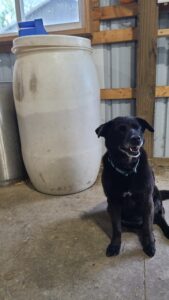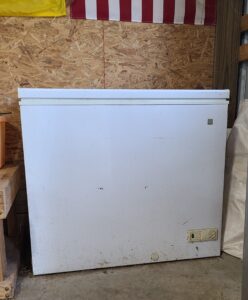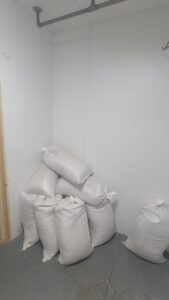To prevent rodent-carried diseases, contamination of your livestock feed, and wasting money, it’s important that grain be stored securely. Here are a range of ideas for keeping mice and rats out of your animal feed.

This post contains affiliate links. As an Amazon Associate, I earn from qualifying purchases.
If you have a few good barn cats, but still notice holes in feed bags from mice, you’re not alone! Rodents can be quite elusive and hard to eradicate from a barn or chicken coop.
The Problem with Rodents in Grain
Like your livestock, mice and rats thrive on grains and will be almost impossible to keep out of feed sacks. Rodents can chew through fabric, cardboard, and plastic and fit through the tiniest of holes and gaps.
These farm pests harbor parasites like lice and mites. Even worse, they carry diseases like leptospirosis and salmonella that can be transferred to your livestock and in turn, humans as well.
If that’s not bad enough, while munching on your animal’s feed, mice and rats urinate and defecate on it which can make your livestock sick or go without eating. This leads to loss of body condition and productivity.
Mouse traps are not going to stop them, and rat poison isn’t safe for use around livestock. If you want to avoid your animals suffering, vet bills, and wasting your money, you need to find a way to keep the rodents out of the livestock feed.
Here are 6 ways to mouse-proof your grain, and still have access to it at chore time. With options ranging from storing 10 pounds of feed to 2,000 pounds, there is something for both the hobbyist and commercial producer.
1. Using a 5-gallon Bucket with Lid for Grain Storage
If you only need to store a small amount, a 5-gallon bucket with a good-fitting lid will work well. Personally, I use these for storing small packages of supplements and treats for my animals.
2. Using an 18-gallon Rubbermaid Tote for Grain Storage
The 18-gallon Rubbermaid tote will give you much more room for storage. These will hold about 50 pounds of feed. I use them for storing cat food for the barn kitties and bird seed.
3. Using a 50-gallon Barrel with Lid for Grain Storage
In our barn, we have a barrel for each kind of animal feed. There is one for the horses, goats, pigs, and chickens. Everything stays organized and there aren’t feed sacks all over the place.
The barrel shown holds about six 50-pound bags of animal feed. You will need a feed scoop to get the grain out of the lowest quarter of the barrel.
4. Using an Old Freezer for Grain Storage

You can use an old, nonworking chest freezer to store a lot of livestock feed. This is a very economical solution to the rodent problem because people often give away and consider un-working freezers trash. Look for them on Marketplace or on the side of the road!
Put feed sacks inside the freezer or empty them into the freezer itself, your pick. The freezer is airtight, mouse-proof, and easy to get in to. The top doubles as a handy table for setting things on as well.
5. Using a Walk-in Cooler for Grain Storage

If you have a walk-in cooler, you have an entire room that is rodent-proof! When we don’t have animals hanging, we use it to store stacks of 50 pound bags of grain. Having a room to store grain in allows us to buy in bulk, which helps lower costs and saves us trips to the mill.
We built our own walk-in cooler by framing and insulating a corner of our barn. We use a window air conditioner and CoolBot to regulate the temperature of the FRP lined room. When the CoolBot is on, it works great for hunting season and on-farm butchering. When it’s off, we use the room for grain storage!
You can get 25 dollars off your own CoolBot by using my referral link: https://storeitcold.referralrock.com/lv1/UMAK3BXC/
6. Using a Hopper Bin for Grain Storage
If you go through a lot of grain on your operation a top-filled, gravity fed bin with a slide gate to release feed is probably the best option. These types of bins are super useful because they are like little silos for holding a few tons of feed and they are rodent proof if they are well maintained.
I don’t have one on my farm, and don’t foresee getting one, because we are moving toward rotational grazing and exclusively grass-fed livestock. However, I think conventional mid-to-large scale farmers would find a feed bin a worthwhile investment.
A Reminder about Any Method of Grain Storage
It doesn’t matter if you are using a bucket, barrel, or hopper bin, it is important to make sure that you empty the vessel each time, before refilling it. Failing to do so can lead to mold and spoilage of the grain, which can make your animals sick!
Are you using something else creative to store your animal feed? I would love to hear about it, drop the information in the comments below!

Mother, farmer, author, and teacher by trade… She loves tending to things and watching them grow!
